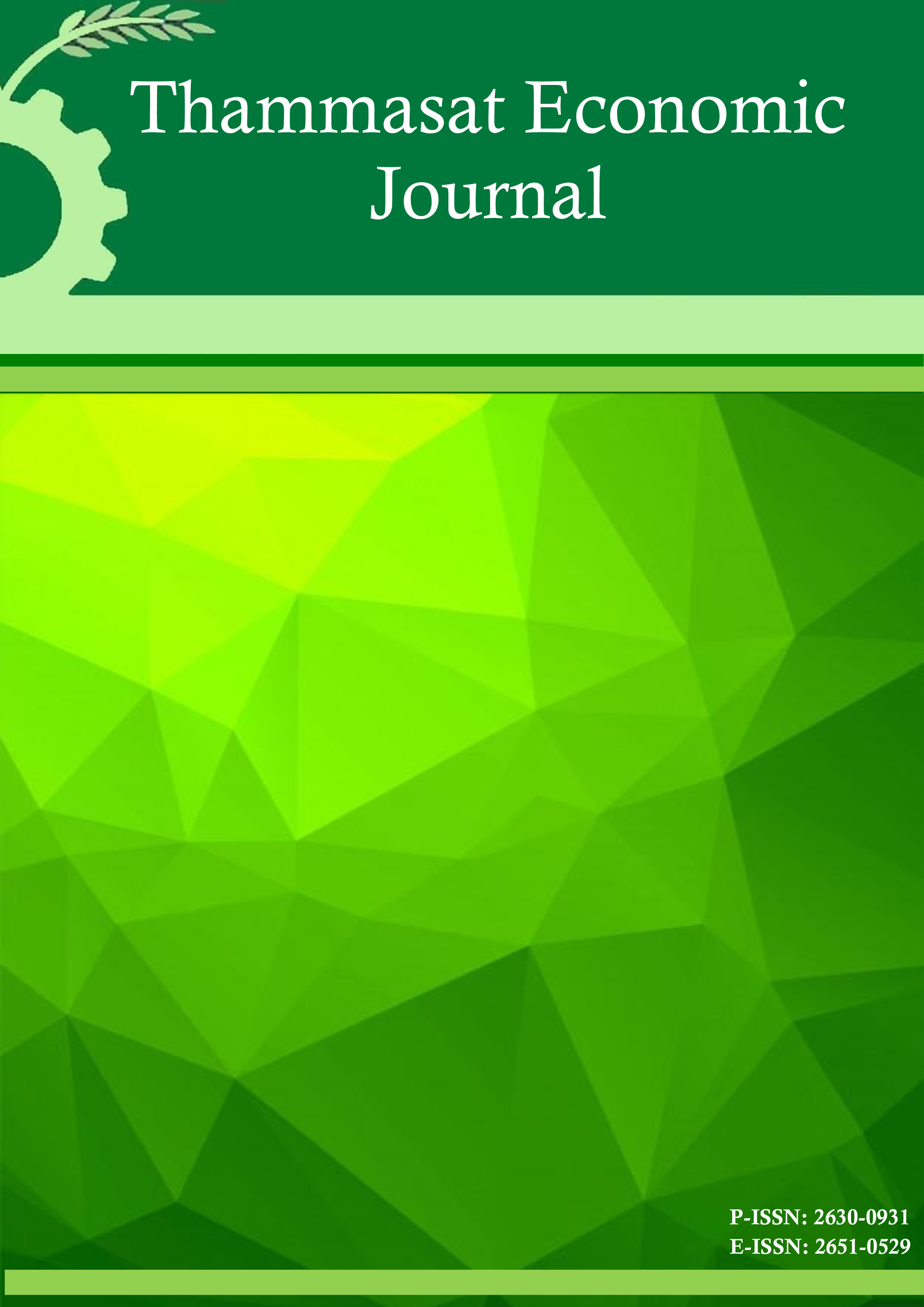An Analysis of the Real Interest Rate and Monetary Policy under Regime Shifts
คำสำคัญ:
Nonstationary series, real interest rate, unit root, stochastic process, vector autoregressions, monetary policyบทคัดย่อ
ค่าอัตราดอกเบี้ยที่แท้จริง ( Real interest rate) เป็นประเด็นที่สำคัญในทฤษฎีเศรษฐศาสตร์มหภาคและมีบทบาทเด่นมากในนโยบายทางการเงิน บทความนี้ขยายจำนวนเวลาของข้อมูล (Time Series) ที่ Garcia and Perron (1996) ใช้ในการวิเคราะห์อัตราดอกเบี้ยที่แท้จริงของสหรัฐอเมริกา โดยมีจุดประสงค์จะตรวจสอบผลการศึกษาของบทความดังกล่าว และต้องการเพิ่มความเข้าใจเกี่ยวกับลักษณะเชิงพลวัตของค่าอัตราดอกเบี้ยที่แท้จริงในช่วงหลังสงครามโลกครั้งที่สอง การประมาณการค่าของตัวกลางทางคณิตศาสตร์ (Mean) และความเบี่ยงเบน (Variance)ของอัตราดอกเบี้ยที่แท้จริงในบทความนี้ใช้แบบจำลอง Three-State Markov Switching และ Hamilton Filter ส่วนการพิจารณาว่าการปรับเปลี่ยนนโยบายทางการเงินจะมีผลกระทบต่อการเปลี่ยนแปลงของค่าของอัตราดอกเบี้ยที่แท้จริงหรือไม่นั้น ใช้แบบจำลอง Three-Variable Recursive Vector Autoregression (VAR) ซึ่งประกอบดว้ยตัวแปรอัตราการว่างงาน อัตราเงินเฟ้อ และอัตราค่าดอกเบี้ยระยะสั้น
บทความนี้พบว่าค่าของตัวกลางทางคณิตศาสตร์ (Mean) และความเบี่ยงเบน (Variance) ของอัตราดอกเบี้ยที่แท้จริง มีค่าที่แตกต่างกันในช่วงปี 1954-1973, 1973-1981, 1981-1986, 1986-2002 และ 2002-2006 อย่างไรก็ตาม เมื่อพิจารณาจาก Impulse Response Analysis ของ VAR บทความนี้ยังสรุปไม่ได้ว่านโยบายทางการเงินเป็นตัวแปรหลักที่ทำให้เกิดการปรับค่าของอัตราดอกเบี้ยที่แท้จริง ควรจะมีการศึกษาเพิ่มเติมเพื่อวิเคราะห์และพิจารณาถึงสาเหตุการปรับค่าของค่าอัตราดอกเบี้ยที่แท้จริงโดยใช้แบบจำลองร่วมที่ประกอบด้วย ค่าของอัตราดอกเบี้ยที่แท้จริงนโยบายทางการเงิน และแนวโน้มของอัตราเพิ่มของผลผลิต (Output trend growth rate) ในการอธิบายลักษณะเชิงพลวัตของค่าอัตราดอกเบี้ยที่แท้จริงให้ดียิ่งขึ้น ทั้งนี้เนื่องจากมีผลการศึกษาที่ชี้ให้เห็นว่าการเปลี่ยนแปลงของความพอใจ (Preference) และเทคโนโลยีมีผลต่อลักษณะเชิงพลวัตของค่าอัตราดอกเบี้ยที่แท้จริงด้วย
เอกสารอ้างอิง
2. Balke, N., and Emery, K. (1994) The Federal Funds Rate as an Indicator of Monetary Policy:Evidence from the 1980s, Economic Review (First Quarter).
3. Ball, L. (1990) Time-Consistent Policy and Persistent Changes in Inflation, NBER WorkingPaper Series, No. 3528 (Cambridge, Mass.: National Bureau of Economic Research, December).
4. Bernanke, B., and Blinder, A. (1990) On the Predictive Power of Interest Rates and Spreads, Federal Reserve Bank of Boston New England Economic Review, November/December, pp. 51-68.
5. (1992) The Federal Funds Rate and the Channels of Monetary Transmission, American Economic Review 82 (September), pp. 901-921.
6. Bollerslev, T. (1988) Integrated ARCH and Cointegration in Variance, mimeo, Northwestern University.
7. Bosworth, B. (1989) Institutional Change and the Efficacy of Monetary Policy, Brookings Papers on Economic Activity, no. 1, pp. 77-110.
8. Fama, E. (1975) Short-term Interest Rates as Predictors of Inflation, American Economic Review 65, pp. 269-282.
9. Garcia, R., and Perron, P. (1996) An Analysis of the Real Interest Rate under Regime Shifts, The Review of Economics and Statistics, Vol. 78, No. 1. (February), pp. 111-125.
10. Goodfriend, M. (1992) Interest Rate Policy and the Inflation Scarce Problem: 1979-1992, Federal Reserve Bank of Richmond 1992 Annual Report, pp. 7-19.
11. Hamilton, J. (1989) A New Approach to the Economic Analysis of Nonstationary Time Series and the Business Cycle, Econometrica 57, pp. 357-384.
12. Huizinga, J., and Mishkin, F. (1986) Monetary Policy Regime Shifts and the Unusual Behavior of the Real Interest Rates, Carnegie-Rochester Conference on Public Policy 24, pp. 231-274.
13. Kahn, G. (1989) The Changing Interest Sensitivity of the U.S. Economy, Federal Reserve Bank of Kansas City, Economic Review 74 (November), pp. 13-34.
14. Laurent, R. (1988) An Interest Rate-Based Indicator of Monetary Policy, Federal Reserve Bank of Chicago, Economic Perspectives, January/February, pp. 3-14.
15. McCallum, B. (1983) A Reconsideration of Sims’ Evidence Concerning Monetarism, Economics Letters 13 (2-3), pp. 167-71.
16. Perron, P. (1990) Testing for a Unit Root in a Time Series with a Changing Mean, Journal of Business &Economic Statistics 8, pp. 153-162.
17. Romer, C., and Romer, D. (2002) A Rehabilitation of Monetary Policy in the 1950s, NBER Working Paper Series, No. 8800 (Cambridge, Mass.: National Bureau of Economic Research, February).
18. Rose, A. (1988) Is the Real Interest Rate Stable?, Journal of Finance 43, pp. 1095-1112.
19. Sims, C. (1986) Are Forecasting Models Usable for Policy Analysis? Federal Reserve Bank of Minneapolis Quarterly Review 10 (Winter), pp. 2-15.
20. Stock, J., and Watson, M. (2001) Vector Autoregressions, Journal of Economic Perspectives –Volume 15, Number 4, pp. 101-115.
21. Walsh, C. (1987) Three Questions Concerning Nominal and Real Interest Rates, Economic Review Federal Reserve Bank of San Francisco, No. 4, pp. 5-20.
22. _______(1988) Testing for Real Effects of Monetary Policy Regime Shifts, Journal of Money, Credit and Banking, pp. 393-401.







